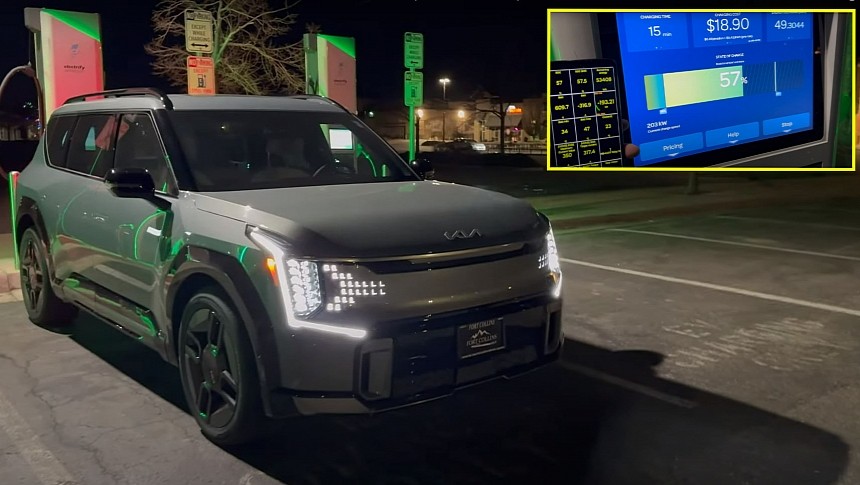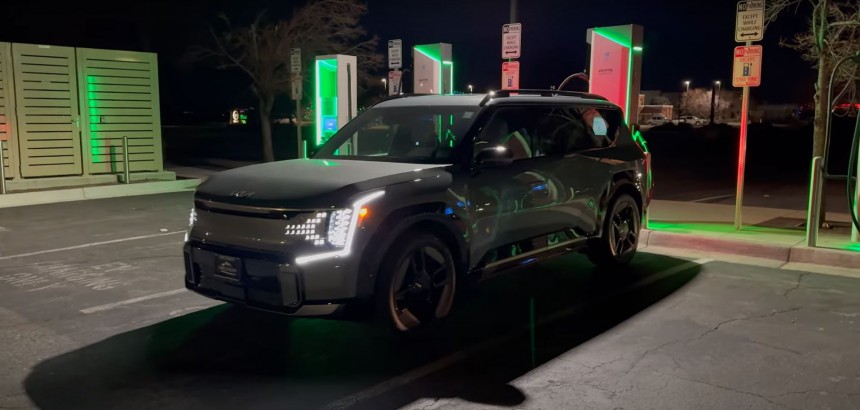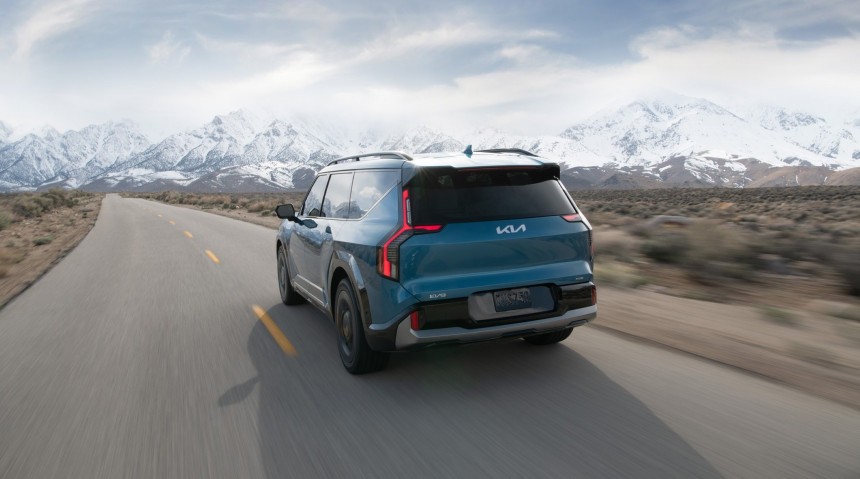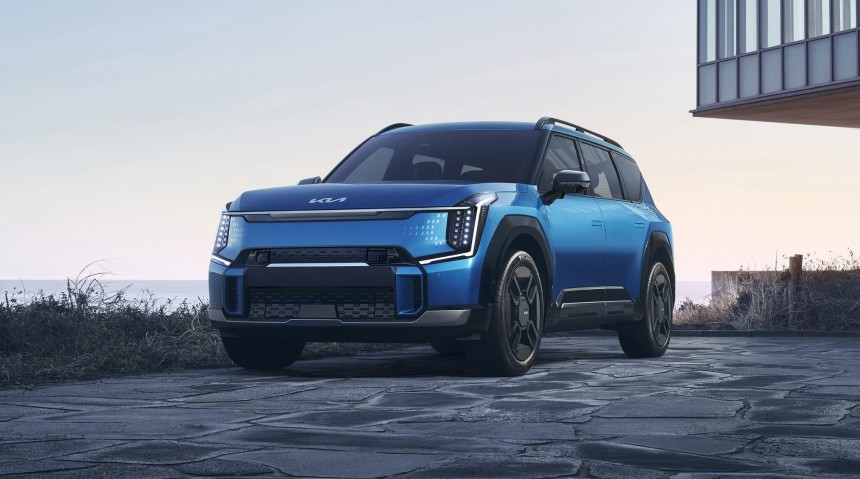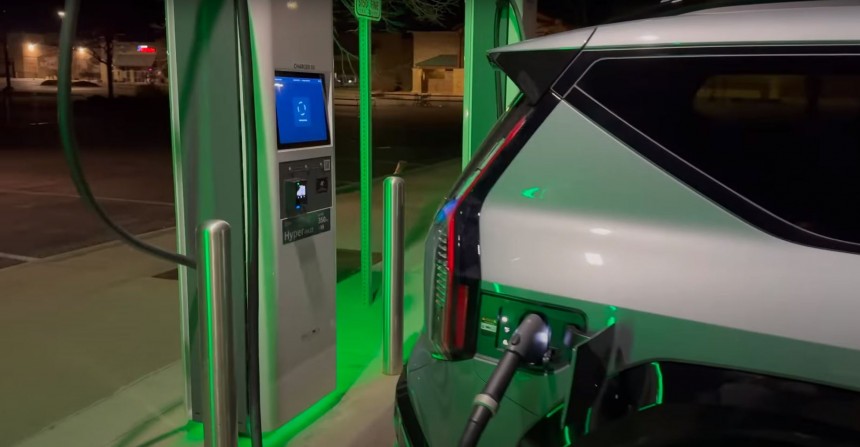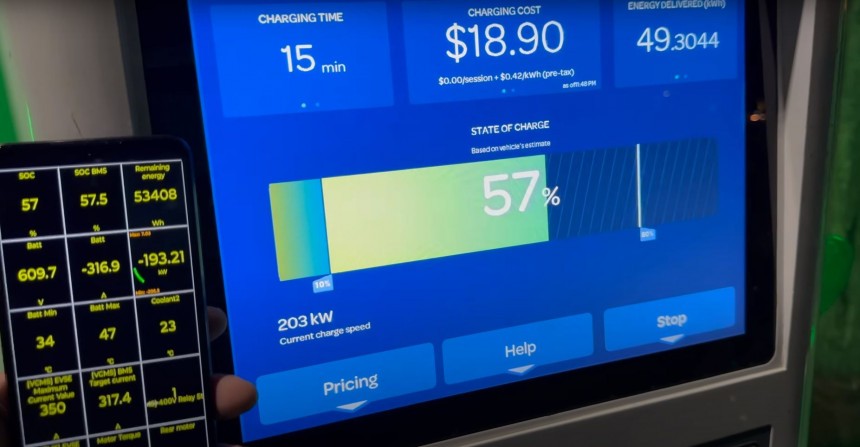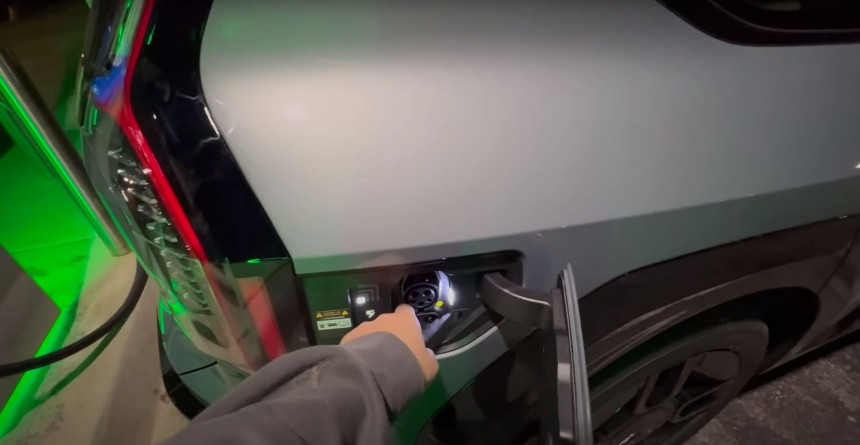Spending almost $80,000 (with tax and freight) on a Kia can seem outrageous. However, the brand evolved tremendously in the last few years. The latest lineup refresh and the gradual move to battery-electric drivetrains helped the Hyundai Group member gain a new, more robust identity. Now, the EV9 proves Kia's on the right path. Here's why we're saying that.
For many people living in North America, buying an all-electric vehicle is incredibly simple. Just pick your favorite Tesla, and that's it. The world's most valuable automaker's zero-emission rides have it all: speed, tech, sufficient range across the board, seamless access to a reliable high-power charging network, and a community you can count on.
However, other entrepreneurs learned from Tesla and successfully launched competitors that make choosing a Tesla a bit more complicated. Don't like the Cybertruck? Get a Rivian R1T. Think the Model S is not very refined? Choose the Lucid Air. The Model Y's shape isn't to your liking? Check out Ford's Mustang Mach-E.
The latter being offered by a legacy automaker shows that the disruptor might not have the early mover advantage anymore. Other industry players are catching up, and they could end up doing a better job than Tesla.
Take Kia as an example. The EV9 lands in a very competitive sector without being eligible for the new EV tax credit. The R1S and Model X were the only three-row eSUV options Americans had.
Admittedly, the latter wasn't very friendly with those sitting in the last row of seats, but it at least had them. Now, the electrified and somewhat minivan-ified Telluride wants to convince you that it is worthy of your hard-earned cash.
If you want the best range, you'll have to go with the Light Long Range version. That's the rear-wheel-drive EV9, which comes with the big 99.8-kWh high-voltage energy storage unit. It'll drive for 304 miles before depleting all its cells but comes at a $4,300 premium over the entry-level model.
The best-looking and most well-equipped EV9 is the dual-motor GT-line, which has an MSRP of $73,900. The powertrain has an output of 379 hp and 443 lb-ft of torque. However, the downside is that the EPA-rated range drops to 270 miles.
We previously told you about a real-world 70-mph range test performed with the EV9 GT-line. The journey happened in Eco Mode, with only the driver being inside the SUV. The result initially seemed a bit discouraging because the powertrain's output was limited after 250 miles. The battery nearly tapped out.
However, the good news was that the vehicle kept going for 16 more miles. As such, you could make it to a rapid charger or a domestic socket even after reaching 0% state of charge.
The bottom line is that you should be able to comfortably squeeze 200 miles of highway range out of a full battery when traveling at an average speed of 70 mph with a couple of passengers on board. After all, this three-row six-seater is meant for families and people with friends.
Just for reference, the newest V6-powered Kia Telluride with all-wheel drive consumes 25 mpg when it must gallop on highways. Considering that the SUV is equipped with an 18.8-gallon fuel tank, the maximum range you would get by traveling at an average speed of 70 mph is 474 miles. That's more than double the distance the EV9 can cover on a single charge.
The Telluride is also $20,000 cheaper than the eSUV. Should we also point out that filling up with gas is more convenient (and even more affordable in some cases) than charging?
However, the EV9 has a couple of aces up its sleeve.
But no matter how anyone might feel about battery-electric vehicles, we must not forget that fast charging is tricky. Imagine you're the one who runs Michigan Stadium and have to ensure that over 107,000 people find their assigned seats in due course. It's easy with the first few hundred because the stadium is empty, and they require minimal or no assistance to find their spots. But as tens of thousands try to do the same thing, it gets complicated. It might take ages for a person to reach their seat. And when they eventually do find their place, someone else might be sitting there. A conflict may arise.
That's what happens in a high-voltage battery. As the state of charge increases, the charging speed decreases. That's why good battery management systems are crucial. They make sure the electrons reach the cells gradually. That's how the longevity of the energy storage unit is ensured.
Even though good progress has been made in this regard (just look at the Lucid Air), the battery tech that's mainstream today still doesn't allow carmakers to play catchup with traditional vehicles. Filling up with gas or diesel takes a couple of minutes, and it's easy. Plugging into a DC dispenser may require having an app, waiting for confirmation, and making sure the pedestal has the right connector. Moreover, if there's a problem at the fuel station, there's personnel that can help. At a Supercharger or Electrify America station, you have nobody to go to for immediate assistance.
That's why automakers are rushing to come up with battery packs boasting higher voltages. Not only does an EV's energy storage unit built on the 800V architecture charge faster, but it can also minimize energy losses. When charging, almost 10% of the electricity you pay for is spent on running some auxiliaries and keeping the equipment at the right temperature. Simply put, you pay for 110 kWh, but you only get 100 kWh.
The same issue is what prompted Tesla to move to the 48V architecture for the low-voltage system. The higher the voltage, the lower the resistance. The result? Increased efficiency! 800V+ battery packs and 48V systems also help reduce weight and lower production costs. Both allow for thinner wiring and plugs that don't heat as fast as the ones that are currently in service.
The fastest-charging EV Americans can buy right now is the 1,050-hp Lucid Air Grand Touring, which has a 112-kWh battery back boasting the 900V+ electrical architecture. Find a working 350kW+ DC fast charger and it can add 208 miles of range in 20 minutes. But that type of performance doesn't come cheap. The sedan has an MSRP of $125,600.
But more important than charging fast is maintaining that impressive speed. Remember the empty stadium I told you about earlier?
Here's the unexpected surprise: the nearly half-as-cheap and top-of-the-line EV9 is not bad at charging when you most need it.
Out of Spec Reviews arrived at the Electrify America DC stall with the EV at 10% state of charge. The reviewer didn't precondition the battery pack beforehand. A cold, high-voltage energy storage unit is supposed to charge slower. It's worth noting that it's possible to do so manually until the 10% state of charge threshold is reached.
Despite not having met the ideal conditions for rapid charging, the EV9 still pulled electrons from that dispenser at a rate of 191 kW immediately. It quickly went up to 200 kW, though! After 10 minutes, the state of charge went up to 40%. That's an impressive start for an eSUV that doesn't have the 800V architecture and no warmed-up battery pack. Keep in mind that this charging performance happened while the A/C was on.
The most important thing is that the EV9 maintained that 200 kW charging speed for 15 minutes, during which it added 49 kWh to the battery and 118 miles of range. That's enough to keep you going without much hassle. It has a great charging curve for what it is.
Sadly, it's still not as good as a gas car in terms of keeping you on the move. But the Kia EV9 stands as proof that you can sell a practical battery-electric vehicle without hemorrhaging money or disappointing customers.
If high-power charging networks continue to expand and key players keep investing in reliable dispensers and software, then we're slowly going to see more and more non-Tesla EVs on the road.
However, other entrepreneurs learned from Tesla and successfully launched competitors that make choosing a Tesla a bit more complicated. Don't like the Cybertruck? Get a Rivian R1T. Think the Model S is not very refined? Choose the Lucid Air. The Model Y's shape isn't to your liking? Check out Ford's Mustang Mach-E.
The latter being offered by a legacy automaker shows that the disruptor might not have the early mover advantage anymore. Other industry players are catching up, and they could end up doing a better job than Tesla.
Take Kia as an example. The EV9 lands in a very competitive sector without being eligible for the new EV tax credit. The R1S and Model X were the only three-row eSUV options Americans had.
Money talks
Pricing starts at $54,900. That MSRP gives you the Light RWD trim that comprises the small 76.1-kWh battery and a motor pumping out 215 hp and 258 lb-ft of torque. EPA testing data reveals a maximum range of 230 miles on a single charge.If you want the best range, you'll have to go with the Light Long Range version. That's the rear-wheel-drive EV9, which comes with the big 99.8-kWh high-voltage energy storage unit. It'll drive for 304 miles before depleting all its cells but comes at a $4,300 premium over the entry-level model.
The best-looking and most well-equipped EV9 is the dual-motor GT-line, which has an MSRP of $73,900. The powertrain has an output of 379 hp and 443 lb-ft of torque. However, the downside is that the EPA-rated range drops to 270 miles.
We previously told you about a real-world 70-mph range test performed with the EV9 GT-line. The journey happened in Eco Mode, with only the driver being inside the SUV. The result initially seemed a bit discouraging because the powertrain's output was limited after 250 miles. The battery nearly tapped out.
The bottom line is that you should be able to comfortably squeeze 200 miles of highway range out of a full battery when traveling at an average speed of 70 mph with a couple of passengers on board. After all, this three-row six-seater is meant for families and people with friends.
Just for reference, the newest V6-powered Kia Telluride with all-wheel drive consumes 25 mpg when it must gallop on highways. Considering that the SUV is equipped with an 18.8-gallon fuel tank, the maximum range you would get by traveling at an average speed of 70 mph is 474 miles. That's more than double the distance the EV9 can cover on a single charge.
The Telluride is also $20,000 cheaper than the eSUV. Should we also point out that filling up with gas is more convenient (and even more affordable in some cases) than charging?
Seeing the (green) light
With EVs, the faster they can charge, the better. You don't want to spend hours plugged in, especially when you're road-tripping. Manufacturers also don't like the idea of having customers turn from ecstatic to disgruntled soon after taking delivery. Seeing your spanking-new, pricey vehicle take ages to add a couple of hundred miles of range can make you lose faith in zero-emission personal transport.But no matter how anyone might feel about battery-electric vehicles, we must not forget that fast charging is tricky. Imagine you're the one who runs Michigan Stadium and have to ensure that over 107,000 people find their assigned seats in due course. It's easy with the first few hundred because the stadium is empty, and they require minimal or no assistance to find their spots. But as tens of thousands try to do the same thing, it gets complicated. It might take ages for a person to reach their seat. And when they eventually do find their place, someone else might be sitting there. A conflict may arise.
That's what happens in a high-voltage battery. As the state of charge increases, the charging speed decreases. That's why good battery management systems are crucial. They make sure the electrons reach the cells gradually. That's how the longevity of the energy storage unit is ensured.
That's why automakers are rushing to come up with battery packs boasting higher voltages. Not only does an EV's energy storage unit built on the 800V architecture charge faster, but it can also minimize energy losses. When charging, almost 10% of the electricity you pay for is spent on running some auxiliaries and keeping the equipment at the right temperature. Simply put, you pay for 110 kWh, but you only get 100 kWh.
The same issue is what prompted Tesla to move to the 48V architecture for the low-voltage system. The higher the voltage, the lower the resistance. The result? Increased efficiency! 800V+ battery packs and 48V systems also help reduce weight and lower production costs. Both allow for thinner wiring and plugs that don't heat as fast as the ones that are currently in service.
Kia's smart approach
The South Korean automaker did none of the above with the EV9. Even though it told everyone the three-row eSUV would have a high-voltage battery with the 800V architecture, the 99.8-kWh energy storage unit is limited to around 550V. In brief, the higher the voltage, the better. It allows for the transmission of more electrical power over long distances by reducing the amount of current that needs to flow. That automatically translates into minimized heat loss in the wires.But more important than charging fast is maintaining that impressive speed. Remember the empty stadium I told you about earlier?
Here's the unexpected surprise: the nearly half-as-cheap and top-of-the-line EV9 is not bad at charging when you most need it.
Out of Spec Reviews arrived at the Electrify America DC stall with the EV at 10% state of charge. The reviewer didn't precondition the battery pack beforehand. A cold, high-voltage energy storage unit is supposed to charge slower. It's worth noting that it's possible to do so manually until the 10% state of charge threshold is reached.
The most important thing is that the EV9 maintained that 200 kW charging speed for 15 minutes, during which it added 49 kWh to the battery and 118 miles of range. That's enough to keep you going without much hassle. It has a great charging curve for what it is.
Sadly, it's still not as good as a gas car in terms of keeping you on the move. But the Kia EV9 stands as proof that you can sell a practical battery-electric vehicle without hemorrhaging money or disappointing customers.
If high-power charging networks continue to expand and key players keep investing in reliable dispensers and software, then we're slowly going to see more and more non-Tesla EVs on the road.
